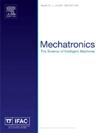Comfort-enhanced longitudinal control for DDEVs: A robust brake coordination approach leveraging reactive anti-dive forces
IF 3.1
3区 计算机科学
Q2 AUTOMATION & CONTROL SYSTEMS
引用次数: 0
Abstract
Distributed drive electric vehicles actuated by in-wheel motors and brake-by-wire systems enable tracking target motion while improving extra vehicle performance. Outboard brake torque allocated on front and rear wheels generates diverse vertically reactive anti-dive forces, providing an innovative approach to mitigate brake dive without requiring active suspensions. However, the differing dynamics of regenerative and hydraulic braking, along with multiple uncertain vehicle parameters, pose significant challenges to achieving robustness under mixed uncertainties. Moreover, pitch-induced bias in onboard acceleration measurements further degrades control accuracy. To address above problems, this paper proposes a robust, comfort-enhanced longitudinal control system with coordinated braking. A three-degree-of-freedom vehicle dynamics model is developed to incorporate the effect of anti-dive forces. For accurate feedback, a robust observer is designed to compensate pitch-variation-related acceleration measurement biases. By integrating dynamic and parametric uncertainties into the control-oriented model, the mixed -synthesis is employed to design a two-degree-of-freedom controller to robustly optimize the acceleration tracking and anti-dive performance. Compared to the controller designed by standard -synthesis, the proposed approach achieves a 10% improvement in robust performance. Real-vehicle experiments validate the system’s effectiveness, demonstrating over a 27% reduction in pitch angle while maintaining satisfactory acceleration responses under blended braking conditions.
DDEVs纵向舒适控制:一种利用反俯冲力的稳健制动协调方法
分布式驱动电动汽车由轮内电机和线控制动系统驱动,能够跟踪目标运动,同时提高车辆的额外性能。分配在前轮和后轮上的外侧制动扭矩产生不同的垂直反俯冲力,提供了一种在不需要主动悬架的情况下减轻制动俯冲的创新方法。然而,再生制动和液压制动的不同动力学特性,以及多种不确定的车辆参数,对实现混合不确定性下的鲁棒性提出了重大挑战。此外,机载加速度测量中的俯仰引起的偏差进一步降低了控制精度。为了解决上述问题,本文提出了一种鲁棒性、舒适性增强的纵向协调制动控制系统。建立了考虑抗俯冲力影响的三自由度飞行器动力学模型。为了获得准确的反馈,设计了一个鲁棒H2/H∞观测器来补偿与俯仰变化相关的加速度测量偏差。通过将动态不确定性和参数不确定性集成到面向控制的模型中,采用混合μ综合方法设计了二自由度控制器,对加速度跟踪和抗俯冲性能进行了鲁棒优化。与采用标准μ合成方法设计的控制器相比,该方法的鲁棒性能提高了10%。实车试验验证了该系统的有效性,表明在混合制动条件下,俯仰角降低了27%以上,同时保持了令人满意的加速响应。
本文章由计算机程序翻译,如有差异,请以英文原文为准。
求助全文
约1分钟内获得全文
求助全文
来源期刊

Mechatronics
工程技术-工程:电子与电气
CiteScore
5.90
自引率
9.10%
发文量
0
审稿时长
109 days
期刊介绍:
Mechatronics is the synergistic combination of precision mechanical engineering, electronic control and systems thinking in the design of products and manufacturing processes. It relates to the design of systems, devices and products aimed at achieving an optimal balance between basic mechanical structure and its overall control. The purpose of this journal is to provide rapid publication of topical papers featuring practical developments in mechatronics. It will cover a wide range of application areas including consumer product design, instrumentation, manufacturing methods, computer integration and process and device control, and will attract a readership from across the industrial and academic research spectrum. Particular importance will be attached to aspects of innovation in mechatronics design philosophy which illustrate the benefits obtainable by an a priori integration of functionality with embedded microprocessor control. A major item will be the design of machines, devices and systems possessing a degree of computer based intelligence. The journal seeks to publish research progress in this field with an emphasis on the applied rather than the theoretical. It will also serve the dual role of bringing greater recognition to this important area of engineering.
 求助内容:
求助内容: 应助结果提醒方式:
应助结果提醒方式:


